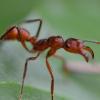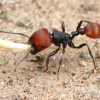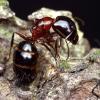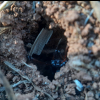In this journal I will talk about ants that I currently have in my possession, and will talk about past failures in a separate post.
As of today, November 11, 2017, I have:
11 Camponotus Semitestaceus queens in test tube setups.
This is a nocturnal species, and I caught them in Tennessee Valley, a small nature park in Marin. I caught 17 of them between two nights, 11 the first, 6 the second. I noticed the first queens on the ground September 22 at 7:43 PM, shortly after the sun set. A week after they were put in their test tubes, I checked on them to insure that nothing was amiss and found that 6 of the had perished to a yellow fungus that grew all over their bodies like sand grains. I removed those test tubes from the drawer and sterilized them. After checking on these queens a month later, October 30, they were still acting very skittish and frightened, and none had laid eggs.
2 Formica spp. queens in test tube setups.
I caught these Formica queens on the road up to Tennessee Valley on August 2, at around 2:50 PM. There were originally 3, with 2 of them retaining their wings. One shortly shed them after being put in the test tube, but the other held onto them until she was found dead at the monthly check of September 5th. As of October 30th, they still had not laid eggs.
1 Monomorium ergatogyna queen in a test tube setup.
I found this solitary Monomorium queen in the sand dunes of Ocean Beach, specifically at the Taraval intersection of the Great Highway, I believe June 22 around 4:00 PM. Since then, she has had several nanitics but cannot seem to keep them alive, which could possibly be my own fault. I believe these ants generally have multiple queens, up to 6, and this may be part of the reason she is struggling.
1 small colony of Tapinoma sessile that I am currently trying to move into a test tube setup.
Overturning a rock near my house, I found a full colony of Tapinoma sessile, with the whole colony and the brood (including the queen) firmly attached to the rock on November 11 (Which is today). The colony is very small, so I am currently attempting to move them into a test tube setup. Finding this species is a great surprise, as my neighborhood is completely dominated by Argentine Ants and has been since I moved here 18 years ago. For as long as I can remember, the only ants that survived in the area was a lone cluster of Formica ants that take up one corner, and a Monomorium species that shelters in the same corner.
2 Camponotus modoc queens in test tube setups.
I caught these two queens next to the Emerald Bay, Lake Tahoe, June 24 at 1:07 PM. They remained in their test tubes for about a month before I checked on them July 28 to find that they had laid eggs. Unlike ants that I have caught locally in the Bay Area, which do not hibernate, these queens from the mountains do hibernate, and are currently dormant.
~~~~~~~~~~~~~~~~~~~~~~~~~~~~~~~~~~~~~~~~~~~~~~~~~~~~~~~~~~~~~~~~~~~~~~
I will be updating this topic with information as it becomes relevant.
























